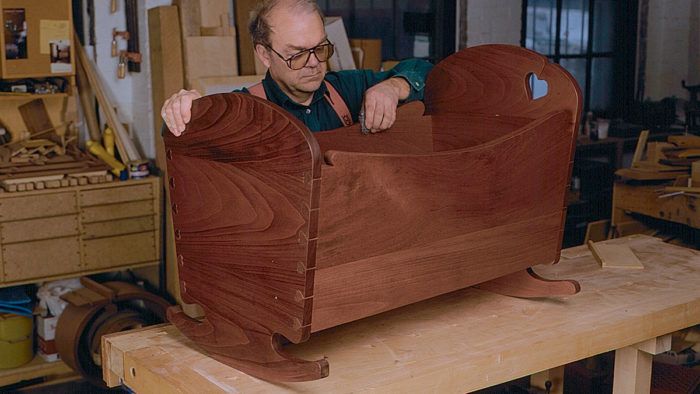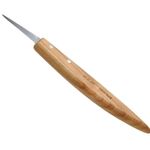Building a Cradle
Slab construction and heart-shaped dovetails
Synopsis: Jacques Berger designed a cradle for a friend and joined it with what he called “lovetails,” or heart-shaped dovetails. It’s basically an open box made with simple slab construction, using flat boards sawn to shape. He explains his design process – how to make the piece lightweight and with proper dimensions. He also talks about determining the radius for the rockers, for gentle rocking without tipping. He used Brazilian mahogany but recommends a lighter color wood. He explains how he worked the corner joinery and how to assemble it. Side information shows his experimentation with dovetails to get a more interesting look.
My good friend was expecting a baby and I decided to build a cradle for the new arrival. The cradle I designed and built, shown below, is basically an open box made with simple slab construction, using flat boards sawn to shape. The cradle’s corner joints needed to be strong, and since I had been experimenting with unusual variations of dovetails, I decided it would be fun to come up with a special joint for the piece. Because a new baby is such a sweet thing, I designed special heart-shaped dovetails that I call “lovetails.” Further, I thought these exposed corner joints enhanced the look of the simple cradle so well that I decided to develop the lines of the cradle around this theme. Before I get into how I constructed the cradle and cut the lovetails, I’ll tell you more about how my design evolved.
The design
Although I wanted my cradle to be a precious piece of furniture to be kept as a family heirloom after the baby has grown, I also wanted the design to allow simple construction. My cradle is basically a box with trapezoid-shaped ends, which have sawn rockers on the bottom. I made the cradle rather small, so it wouldn’t be too heavy and unmanageable. As you can see in figure 1 on the facing page, the cradle is 36 in. long, with the ends tapering from 19 in. wide at the top to 16 in. at the bottom of the joined sides. These dimensions allowed me to make the cradle 13 in. deep, enough to prevent an active baby from falling out and to allow the cradle to be used safely until the baby starts sitting up and needs a full-size crib.
One of the most important design parameters for the cradle is the radius of the rockers and their location in relation to the box. If the box is too high, it becomes too tippy; if it is too low, it doesn’t look right. I found that 5 in. between the bottom of the rockers and the bottom of the box is just right, both for appearance and stability. The radius of the rockers must also be planned carefully to allow the cradle to rock gently, without tipping, If the rocker’s radius is too long, the cradle comes to rest very quickly; if it’s too short, the cradle becomes tippy. After a little experimentation, I settled for a radius of 25 in. I also added a slight knob on the rocker ends, for a little extra protection against tipping too far.
From Fine Woodworking #83
For the full article, download the PDF below:
Fine Woodworking Recommended Products

Freud Super Dado Saw Blade Set 8" x 5/8" Bore

Pfiel Chip Carving Knife

Suizan Japanese Pull Saw





















Log in or create an account to post a comment.
Sign up Log in